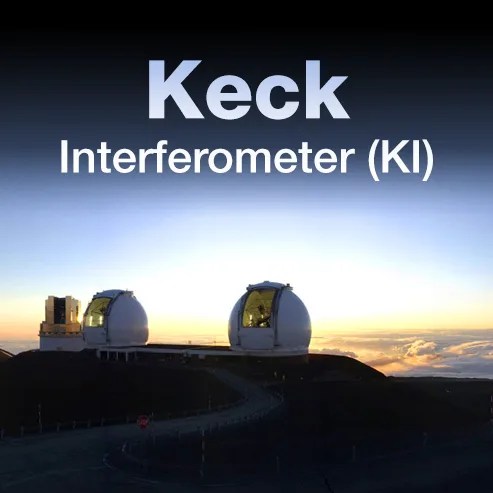Keck Interferometer (KI)
Keck Interferometer
Type
Launch
Location
Objective
The Keck Interferometer was a ground-based component of NASA's Exoplanet Exploration Program. At 4,150 meters (13,600 feet) above the Pacific Ocean, atop the dormant volcano Mauna Kea on the "Big Island" of Hawaii, the twin Keck Telescopes have the largest collecting areas of any optical or infrared telescope (as of July 2015 when this page was last updated). The Keck Interferometer joined these giant telescopes to form a powerful astronomical instrument.
The basic concept for the Keck Interferometer was described in the TOPS (Toward Other Planetary Systems) report and restated in the 1996 Road Map for the Exploration of Neighboring Planetary Systems, reviewed by a blue ribbon panel chaired by Professor Charles Townes, a Nobel Prize winning physicist. In 1996, in response to the recommendations of these and other advisory committees, NASA embarked on a program to implement the Keck Interferometer project. NASA selected JPL to implement the interferometer jointly with the California Association for Research in Astronomy (CARA). In 1996, NASA also joined as a partner in the Keck Observatory.
Since 2003, the Keck Interferometer has been in scheduled operation for a range of peer-reviewed science programs. For example, KI observations have been used to study questions about the origins of stars and galaxies. Recent results include observations of disks around young stars which may be in the process of forming planets, and measurements of the massive disks of gas and dust surrounding the black holes at the center of several nearby galaxies.
The Keck Interferometer was operational from 2003 to 2012 and was used for a range of peer-reviewed science programs. Science highlights from the visibility mode include:
- Active Galactic Nuclei (AGN): The Keck Interferometer (KI) was the first optical/near-infrared interferometer to detect an object outside our own galaxy. In Swain et al. (2003), the KI observations demonstrated that the nuclear emission was very compact and consistent with origin from an accretion disk. Later work (Kishimoto et al. 2009 and Kishimoto et al. 2010) measured several additional AGN and found a scaling between the measured near-infrared size and the AGN luminosity. KI observations of NGC 4151 were also used as part of a new technique to accurately measure the distances to nearby AGN (Hoenig et al. 2014).
- Formation of stars and planets: As the first of the operational large-aperture near-infrared interferometers, KI’s sensitivity level opened up size measurements of larger samples of circumstellar disks around young stars including T Tauri stars (Colavita et al. 2003, Akeson et al. 2005, Eisner et al. 2007) and their more massive counterparts, the Herbig Ae/Be stars (Monnier et al. 2005, Tannirkulam et al. 2008, Ragland et al. 2009). KI’s sensitivity also allowed spectrally dispersed observations of these objects probing the relative spatial distribution of gas and dust within the disk (Eisner et al. 2007, Eisner et al. 2009).
NASA’s primary goal in developing and operating the two 10-m telescope KI was the characterization of faint dust disks around nearby main sequence stars. This was accomplished with the nulling observational mode (Colavita et al. 2009, Serabyn et al. 2012) and a NASA Key Science program surveying dozens of nearby potential planet host stars to search for faint dust clouds. These dust clouds reflect light and give off heat, and so interfere with the search for planets. Analysis of this survey by Millan-Gabet et al. (2011) and Mennesson et al. (2014) set the best limits to date for dust disks around these stars, which helps guide designs for future planet finding missions. With this goal accomplished NASA funding for the KI was discontinued in 2012.
Last Updated: July 29, 2015




























